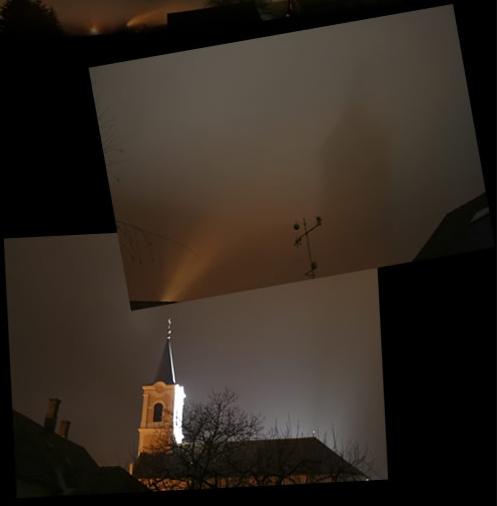Fog Shadows, Hungary
Fog Shadows, Hungary: An Enigmatic Phenomenon Revealed
Fog shadows have long captivated the imagination of onlookers, and the ethereal display captured in Schmall Rafael's photograph at Somogy, Kaposfo, Hungary is no exception. This intriguing optical phenomenon occurs when light interacts with fog, creating a mesmerizing interplay of shadows and volumes. Let's delve deeper into the fascinating world of fog shadows and unravel the mysteries they hold.
The Dance of Light and Shadows
In the captivating image, the floodlight positioned at the far right casts a twisted and seemingly colossal shadow of the nearby church into the sky. It is important to note that fog shadows can manifest as a combination of 2D and 3D shadows. The 2D shadows resemble those cast on a wall, while the 3D shadows take the form of volumes of dark air.
The Illusion of Size
Size can be deceptive when observing shadows in the sky. At times, these shadows may appear larger than life due to their proximity to the viewer compared to the object casting them. Even when cast by the sun's nearly parallel rays, shadows of mountains and clouds can be similarly distorted, creating an illusion of grandeur.
Unveiling the Science Behind Fog Shadows
To understand why fog shadows exhibit their enigmatic qualities, we must explore the interplay between light, fog droplets, and perception. When light encounters fog droplets suspended in the air, these tiny particles scatter the light in various directions. Some of this scattered light reaches our eyes or camera, illuminating the surrounding fog and creating an ethereal glow.
The Role of Shadow Volumes
In the case of 3D shadow volumes within fog, their darkness arises from the absence of scattered light. These unlit volumes appear darker because the surrounding lit water droplets primarily scatter light towards the observer. This contrast between the illuminated fog and the unlit shadow volumes adds depth and intrigue to the overall spectacle.
A Closer Look at Atmospheric Distortions
The distortion of shadows in the sky, as observed in foggy conditions, highlights the complexities of atmospheric optics. The interplay between light, particles, and the viewer's perspective can lead to intriguing visual phenomena. Fog shadows offer a unique glimpse into the intricate dance of light and shadow that occurs within our atmosphere.
Exploring the Limitless Potential of Atmospheric Optics
The captivating nature of fog shadows reminds us of the boundless possibilities within the realm of atmospheric optics. This field of study encompasses a myriad of optical phenomena, including rainbows, halos, and mirages, each offering its own mesmerizing display. By delving deeper into these phenomena, we gain a greater appreciation for the wonders that unfold above us.
A Gateway to Wonder
Fog shadows, with their blend of mystery and beauty, serve as a gateway to further exploration. They invite us to contemplate the complex interplay between light, fog droplets, and our perception. By observing and documenting these phenomena, we expand our understanding of the natural world and nurture a sense of awe for the intricacies that surround us.
Conclusion: Embracing the Enigma
The fog shadows captured in Hungary by Schmall Rafael offer a glimpse into the captivating world of atmospheric optics. Through their interplay of light and shadow, these enigmatic phenomena leave us spellbound and curious to explore further. By embracing the mysteries that unfold above us, we deepen our connection to the wonders of nature and open ourselves to new realms of discovery. So, next time you find yourself enveloped in fog, take a moment to look up and witness the mesmerizing dance of fog shadows that awaits you.


Fog Shadows at Somogy, Kaposfo, Hungary imaged by Schmall Rafael December 30, '08. ©Schmall rafael, shown with permission.
The floodlight at far right casts into the sky a twisted and apparently huge shadow of the church. Fog shadows can be a mixture of 2D shadow (like those on a wall) and 3D shadow (volumes of dark air). The unlit 3D shadow volumes appear dark because the surrounding lit water droplets scatter light towards the eye and camera.
Size can be deceptive. Shadows in the sky sometimes look huge because they are closer to you than the object casting them. Shadows of mountains and clouds can be similarly distorted even when cast by the nearly parallel rays of the sun.
Note: this article has been automatically converted from the old site and may not appear as intended. You can find the original article here.
Reference Atmospheric Optics
If you use any of the definitions, information, or data presented on Atmospheric Optics, please copy the link or reference below to properly credit us as the reference source. Thank you!
-
<a href="https://atoptics.co.uk/blog/fog-shadows-hungary/">Fog Shadows, Hungary</a>
-
"Fog Shadows, Hungary". Atmospheric Optics. Accessed on November 26, 2024. https://atoptics.co.uk/blog/fog-shadows-hungary/.
-
"Fog Shadows, Hungary". Atmospheric Optics, https://atoptics.co.uk/blog/fog-shadows-hungary/. Accessed 26 November, 2024
-
Fog Shadows, Hungary. Atmospheric Optics. Retrieved from https://atoptics.co.uk/blog/fog-shadows-hungary/.